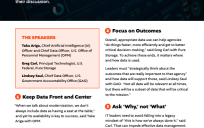 Now seems like a good time to talk about how government professionals can achieve meaningful wins by using data already at hand. Particularly in a context of great challenge, identifying specific problems and visibly solving them will improve governments’ connections with the communities they serve.
Now seems like a good time to talk about how government professionals can achieve meaningful wins by using data already at hand. Particularly in a context of great challenge, identifying specific problems and visibly solving them will improve governments’ connections with the communities they serve.
But most mentions of data can leave public sector employees feeling lost in technical speak. The value in leveraging data is often talked about, but how do non-technical professionals truly realize success while struggling to keep afloat day to day?
The good news is that data analytics is not too technical for government staff to implement. Data is the way policy moves into practice. It helps everyone work smarter, not harder. The key is that data must be married to a service change in order to see results.
To make this a reality in jurisdictions of any size, leaders must find the opportunities for service change. Think of the truffle supply chain. The truffle pigs sniff and dig out truffles, which have significant and immediate market value. Opportunities to use data analytics are the truffles of government. Leaders who find those truffles and bring them to the market will be heroes.
The following are six practical ways to find data analytics opportunities.
1. Find the Needle in the Haystack
It can be difficult at times to identify or locate service recipients. Data analytics can be used to predict locations or identify service targets so that agencies can focus their resources in precise, non-random ways.
In New Orleans, for example, a tragic house fire claimed the lives of five people. The house did not have a smoke alarm. While the fire department had a program through which residents could request smoke alarms, very few people took advantage of it. The fire chief wanted to prevent future tragedies and proactively send firefighters into neighborhoods to query households and provide alarms.
Using data to inform firefighters where to go first gave them a high hit rate and ensured their time was spent valuably. The city used free, federally available housing data along with its own fire incident data to create an algorithm that predicted block groups most likely to have the highest need. Seven months after firefighters provided alarms according to the data, 11 people escaped a house fire in a targeted block because of a new alarm.
2. Prioritize Work for Impact
Operational backlogs are common in governments. Often those backlogs are tackled on a first-in, first-out basis. Data analytics can help agencies triage their backlogs so that services are delivered first to those who need it most. This is even more important for chronically under-resourced agencies in order to get the most bang for their buck in resource deployment.
In New York City, a small team of building inspectors faced an immense backlog, which included illegally converted buildings that were unsafe for residents. When inspectors visited properties based on complaints, 21% were in poor enough conditions to warrant a vacate notice. Data analytics showed that property tax delinquencies were a good predictor of unsafe residences. By simply resorting the backlog to visit tax-delinquent properties first, the hit rate increased to 71%.
3. Use Early Warning Tools
Many government services are reactive and used after problems occur. The opportunity here is apparent: If data analytics can predict problems before they occur, governments can pivot their services to be more preventative than reactive.
In Los Angeles, predictive analysis helped the city better target homeless prevention services. Researchers from the University of California, Los Angeles (UCLA) used data from seven agencies to build a model to predict which high-risk residents were most likely to become homeless. The city then created an action plan for intervention as well as a multidisciplinary homelessness prevention unit that included representatives from all relevant agencies to address risk lists generated by the model and connect people directly to services.
4. Make Better, Quicker Decisions
Some repetitive decisions are made case-by-case, over and over again. Leveraging data to examine prior, similar situations before taking action can provide insight on how to make better future decisions.
With blight a major issue in New Orleans, leaders turned to data to analyze patterns in blight abatement decisions. Once a guilty verdict in a blight hearing was reached, the city could choose to demolish the property or foreclose on the lien and sell the property.
While blight operations had been scaled up, the business process around this end decision remained unchanged. This led to a significant backlog. Whether to demolish or sell was a repetitive decision that was made manually, over and over, on each case. Examining the decisions provided insight into patterns that led to a blight “coin sorter” algorithm that classified cases into “likely sells” or “likely demolitions.” This reduced an 18-month backlog in just 90 days.
5. Optimize Resource Allocation
Oftentimes in government, assets are deployed based on a hunch or, “It’s always been that way.” In this case, data can be used to drive decisions on the deployment of resources based on true need, not anecdote.
The city of Chicago, Illinois reduced complaints about rats by examining the factors that led to rat-related 311 calls. Rat traps had been placed in areas out of habit, but a new look at the leading indicators behind complaints led the city to reallocate rat traps to get ahead of infestation. The algorithm predicted rat complaints would follow water main breaks, illegal dumping or garbage situations, among others, and rat traps were placed accordingly. This reduced rat complaints by 15%.
6. Experiment for What Works
Government sends out mass communications all the time asking residents to take action, from paying a bill to registering for a program. Research shows that very subtle tweaks in how a letter is framed can have significant impact on its effectiveness. Oftentimes, communications are sent across the board without any testing. Employing A/B testing and comparing results can illustrate exactly which messages work so future communications can be adjusted accordingly.
In New Orleans, only 50% of eligible residents took advantage of a new Medicaid program providing primary health care. To encourage participation, the city employed an A/B/C text message test, which showed a clear difference in which wording resulted in significant behavior change and led to more doctor appointments.
By identifying opportunities to analyze data, governments have saved lives, increased productivity, averted crises and cut through backlogs. Meaningful wins that directly help constituents are perhaps more valuable now than ever before.
Meredith Trimble is a former municipal official and Town Council Acting Chair, who focused on strategic planning, annual budgeting and bonded infrastructure projects. Her government experience also includes posts in both federal and state-level executive branch agencies: Associate Editor of the U.S. Federal Election Commission’s FEC Record; and Director of Education for the Connecticut Office of State Ethics. In her current role as a Senior Content Specialist with Tyler Technologies, Inc., she writes content to help empower those who serve the public. Her current focus is to help facilitate data-enabled organizations as well as to create connections between governments and those they serve.





Leave a Reply
You must be logged in to post a comment.